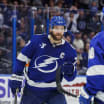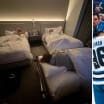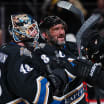As part of the NHL Centennial Celebration, renowned Canadian artist Tony Harris will paint original portraits of each of the 100 Greatest NHL Players presented by Molson Canadian as chosen by a Blue Ribbon panel. NHL.com is unveiling two portraits each day this week.
Today, the portraits of defenseman Larry Robinson and goaltender Ken Dryden are unveiled in the 47th installment.
Robinson, Dryden portraits unveiled
Color paintings of 100 Greatest NHL Players will be revealed on NHL.com during 2017

By
NHL.com @NHLdotcom
Larry Robinson was one of the Montreal Canadiens' "Big Three" on defense, along with Serge Savard and Guy Lapointe. He was a big (6-foot-4, 225 pounds), physical presence in his own zone and an offensive force as well. In an era with some of the most talented defensemen ever to play in the NHL, Robinson was a two-time winner of the Norris Trophy (1977, 1980) as well as the 1978 Conn Smythe Trophy winner as playoff MVP.
Robinson could do everything a coach could ask for. He was big, strong, tough, skilled and smart. The statistic he was most proud of wasn't his 208 goals or 958 points; it was his all-time NHL-best career rating of plus-722, topped by a plus-120 in 1976-77 that is second all-time to Bobby Orr's plus-124 in 1970-71.
He won six Stanley Cup championships with the Canadiens, and in 1989 left Montreal after 17 seasons to sign with the Los Angeles Kings. He played three seasons with the Kings before retiring, having qualified for the Stanley Cup Playoffs each of his 20 NHL seasons. He was inducted into the Hockey Hall of Fame in 1995
In his
NHL100 profile of Robinson
, author Wayne Coffey described the defenseman's 1-on-1 battle with Philadelphia Flyers forward Gary Dornhoefer during the 1976 Stanley Cup Final:
"Robinson didn't have to wait long to force his way into the defensive rotation, ultimately being paired with Savard, who, like Dryden, watched in awe as Robinson's bruising brilliance took hold, particularly in Game 2 of the 1976 Stanley Cup Final, when Robinson drilled Philadelphia Flyers forward Gary Dornhoefer with what longtime hockey broadcaster Bob Miller called, 'the hardest check I have ever seen.'
"The impact was so severe the sideboards came loose and had to be reattached.
"'[Dornhoefer] and I had hammered each other at will,' Robinson wrote in his book, 'Robinson On Defence.' 'It seems as if we had an unspoken agreement: Whenever we met on the ice, it would be a collision. There was no animosity, just two pros acknowledging that the other had a job to do.'
"After the game, Dornhoefer had a stock reply to every reporter who asked about the check.
"'Robinson hits like a pussycat,' he said."
Artist Tony Harris said Robinson impressed the ultimate fan: his father.
"'Larry Robinson was a beast.' That's how my dad, a die-hard Maple Leafs fan, used to describe him," Harris said. "My dad would add that No., 19 was strong, smart, great defensively and equally dangerous in the opposing end. I knew a player was great when my father's descriptions would end with 'I wish the Leafs had him.'"
From the day he arrived in the NHL to the day he left, all Dryden did was win.
The Canadiens called up Ken Dryden in March 1971, and he went 6-0-0 in the final weeks of the regular season. Coach Al MacNeil decided to go with the rookie in the Quarterfinals of the playoffs against the powerful Boston Bruins, who had won five of six games against Montreal during the regular season and had scored an NHL-record 399 goals that season.
The Bruins won the opener 3-1 and led 5-1 in the second period in Game 2 before Montreal scored six consecutive goals for a 7-5 victory. With Dryden in goal, the Canadiens upset Boston in seven games, defeated the Minnesota North Stars in six games in the Semifinals and outlasted the Chicago Black Hawks in a seven-game Final to win the Cup. The rookie goaltender won the Conn Smythe Trophy as playoff MVP
It turned out to be the first of six championships won by the Canadiens from 1971-79 with Dryden in goal.
Dryden was anything but conventional. He came to the NHL from Cornell University at a time when few NHL players came from college hockey. After helping the Canadiens win the Cup in 1973, Dryden and the Canadiens couldn't agree on a new contract and he retired a few weeks before the 1973-74 season to finish his legal studies. After a season apart, Dryden returned to the Canadiens in 1974-75; the next season he and his teammates began a run of four straight championships, and four consecutive Vezina trophies for No. 29.
And then he was gone. Dryden was 31 when he retired in 1979, finishing with a record of 258-57 with 74 ties and a 2.24 goals-against average in 397 games, to go along with six championships. He's gone on to become an author, television commentator (he was the analyst for ABC on its telecast of the U.S. victory against the Soviet Union at the 1980 Lake Placid Olympics), hockey executive and member of Canada's Parliament.
In his
NHL100 profile of Dryden
, Coffey described how he burst onto the scene by frustrating the Bruins during the 1971 playoffs:
"The Bruins scored a 3-1 triumph at home in Game 1, and when they went up 5-1 in Game 2, the rout sure seemed to be on. And then the Canadiens pumped in six unanswered goals and took the 1-1 series back to Montreal, where the 6-foot-4, 210-pound Dryden didn't just stand tall; he morphed into a fortress in pads.
"[Phil] Esposito beat him in the opening minute of Game 3, and then Dryden clamped down on the Boston attack. He stopped a wicked drive by the Bruins' Wayne Cashman. He turned away [a Bobby] Orr blast from 25 feet that seemed a certain goal. At one point in the series, he held the Bruins scoreless for 90 minutes, aided enormously by the counsel of Rogie Vachon, a big-time goaltender who suddenly found himself as Dryden's understudy.
"'Whenever the Bruins pass the puck in front of the net, take it for granted that it will wind up on Phil Esposito's stick and it is already on its way to the goal,' Vachon told Dryden. 'Don't bother studying the puck inch by inch; assume it is going to Espo and assume he is going to shoot. Be ready for him, anticipate him, move into him and you'll be ahead of the game.'
"Dryden listened well. Again and again, Dryden stymied the vaunted Bruins, and was extra mindful of the hulking presence of Esposito, never more so than in the third period of a tight Game 7 in Boston. Esposito rocketed a low hard shot to the right corner, a missile that was going to be a vintage Espo goal until Dryden and his 42-inch left arm reached out and snagged it. Esposito slammed his stick against the glass behind the goal in frustration.
"'A bleeping giraffe,' Esposito called Dryden later."
Harris said Dryden's famed pose -- standing up, toe of the stick on the ice, leaning on the butt end, is among hockey's iconic images.
"Working on Ken Dryden's portrait was dear to my heart, and capturing his iconic pose was very important," Harris said. "It's a pose that every hockey-loving kid from the 1970s has tried to emulate and is as much a part of hockey as Bobby Orr flying through the air or Wayne Gretzky setting up office behind the net."
Larry Robinson

Ken Dryden


















